Keyword
zweidimensionale Reflektionsseismik
78 record(s)
Provided by
Type of resources
Available actions
Topics
Keywords
Contact for the resource
Service types
-
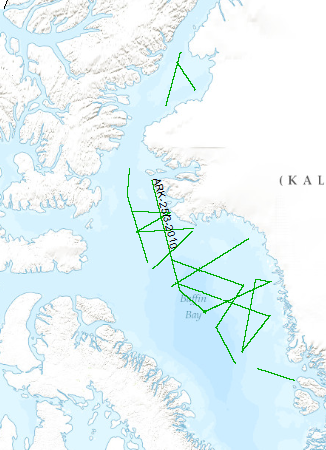
The multidisciplinary marine geoscientific expedition ARK-25/3 was focused on the Greenland part of northern Baffin Bay and was aimed to acquire new geoscientific data to be used for modelling the evolution of the Greenland continental margin and its hydrocarbon prospective. The data format is Society of Exploration Geophysicists SEG Y. The cruise was performed under the direction of the Federal Institute for Geosciences and Natural Resources Hannover in cooperation with the Alfred-Wegener-Institute for Polar and Marine Research, Bremerhaven. Using 70 days of ship time onboard the research icebreaker R/V POLARSTERN a comprehensive data set was acquired along profiles extending from the deep oceanic basin in the central part of North Baffin Bay onto the Greenland continental margin in an area which was bordered by the Kane Basin in the North and Disko Island in the South. By means of multi-channel seismic, wide angle seismic, gravimetric and magnetic methods the structural inventory of the crust in the NW Baffin Bay was investigated. Additionally, heat flow data and sediment cores were collected along lines crossing the Greenland continental margin. The cores were extracted for geochemical and geomicrobiological analysis to be used for basin modelling, studying the hydrocarbon potential, and the hydrocarbon degradation by microorganisms under polar conditions. Geological sampling in the coastal area was done between Melville Bay and Washington Land. The collected rock material will be used to derive constraints on the erosion history of the coastal area. Aeromagnetic data was acquired covering a substantial part of the marine survey area to investigate magnetic signatures of the oceanic crust and the continental margin. This report summarizes the working programme and contains the documentation of acquired data and first results of the expedition.
-
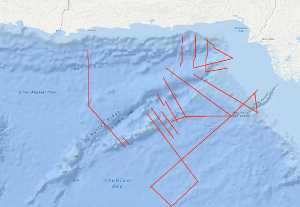
The Sonne Cruise SO122 was carried out by the Federal Institute for Geosciences and Natural Resources (BGR, Hannover) from 3rd August to 9th September 1997, in cooperation with GEOMAR (Kiel), the National Institute of Oceanography (NIO, Karachi) and the Hydrocarbon Development Institute of Pakistan (HDIP). During the joint project with R/V SONNE the Makran accretionary wedge off Pakistan should have been investigated in detail with multi-channel reflection seismics, magnetics and gravimetry. Intense fishery offshore Pakistan forced a change of the area of investigation to the south with the following objectives: investigation of the crustal structure and occurrence of the bottom simulating reflector (BSR) in the Makran accretionary wedge; investigation of the structure of the Murray Ridge System in order to reconstruct the geodynamic evolution of the eastern Indian Plate margin; determination of the origin of the crust underlying the Indus Fan and reconnaissance of the sedimentary history of the Indus Fan in order to reveal the uplift and erosion history of the Himalayas.
-
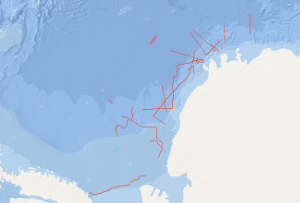
On the F.S. POLARSTERN cruise ANT-IV/3 (6th December, 1985 - 13th March, 1986) multichannel seismic measurements were carried out in parallel with magnetic and gravimetric measurements on 33 lines with a total length of 6,263 km. 3,350 km of the multichannel seismic lines have been processed aboard. The geophysical studies were designed to investigate the structure and geological development of the Weddell Sea continental margin from meridians zero to 60°W, and to define suitable and safe drilling locations for Leg 113 of the Ocean Drilling Program. The main results of the geophysical studies are: (1) The discovery of an approximately N50°E trending failed drift basin, following the trend of a negative magnetic anomaly and a positive gravity anomaly. (2) The discovery of two extensive wedge-shaped and symmetric basement units around a failed drift basin between longitudes 40°W and 20°W. The seismic characteristics, i.e. seismic velocities of 4 km/s and an internally divergent pattern of reflectors suggest that both wedges are formed from extrusive/intrusive volcanic rocks. (3) The confirmation of a major plate tectonic boundary trending approximately N80°E to N60°E, i.e. the EXPLORA-ANDENES escarpment. (4) The confirmation of a glaciogenic progradational wedge beneath the shelf of the Weddell Sea Embayment, made up of several thousand metres of sediments. (5) The definition of 13 suitable and safe drilling locations for ODP-Leg 113.
-
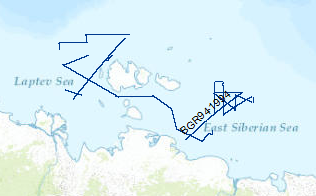
On the M/V Akademic Nemchinow multichannel seismic measurements were carried out on 34 lines with a total length of 4,000 km. The area covered was the Laptev Sea. The data format is Society of Exploration Geophysicists SEG Y.
-
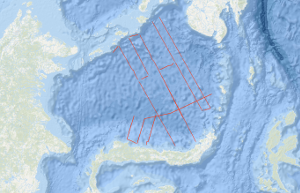
Main target of the project GIGICS (Cooperative German-Indonesian Geoscientific Investigations in the Celebes Sea) is the investigation of the internal crustal structure and the plate tectonic evolution of the Celebes Sea and its active continental margins off Mindanao and Northern Sulawesi. These investigations were carried out during the cruise SO98 of RV SONNE by the Federal Institute for Geosciences and Natural Resources (BGR), Hannover; the German Research Centre for Geosciences (GFZ), Potsdam; the GEOMAR, Kiel; the Institute of Oceanography (IfM), Hamburg; the Mines and Geoscience Bureau, Manila; the Agency for the Assessment and Application of Technology, Jakarta, and the Institute of Oceanography, Wormley. The cruise SO98 consisted of three legs of two weeks duration and one leg of four weeks duration. The total amount of data acquired during the cruise were: - 3,300 km of multichannel reflection seismics, - over 6,800 km of gravimetric and magnetic data and approximately 10.000 km of swath bathymetric and sediment echosounder data, - 3 wideangle-/refractionseismic profiles, each of 120 - 150 km length, - geological, geochemical sampling and oceanographical measurements at a total of 37 stations. During the cruise SO98 a widespaced but regular grid of magnetic and gravimetric profiles were acquired in the eastern part of the Celebes Sea from which up to then reliable data were very sparse. WEISSEL (1980) recognized in the western Celebes Sea WSW-ENE striking magnetic lineations, which he interpreted as chrons 18 - 20 (39 - 43 Ma according to the timescale of HARLAND et al. (1990)). The data from cruise SO98 show that there is no continuation of these anomalies to the east. In the eastern part the magnetic field of the Celebes Sea is less clear and much more disturbed. Nevertheless, E-W-striking anomalies are recognizable. Because amplitudes of local magnetic anomalies are higher than the lineations, the correlation of these lineations with the magnetic reversal scale is still somewhat ambiguous. The gravity map compiled from the measured gravimetric data shows elongated positive anomalies in the eastern part of the Celebes Sea. Exceptions occur at the deep sea trenches off North Sulawesi (North Sulawesi Trench) and Mindanao (Cotabatu Trench) and at the Sulu Archipelago where strong negative gravity anomalies were found. A remarkable NW-striking gravity high of up to 60 mgal was found in the central eastern part of the Celebes Sea. Gravimetric modelling suggests that this high can be correlated with the gravimetric effect of the Molucca Sea Plate subducting from the east under the Sangihe Arc. The reflection seismic data from the northern part of the Celebes Sea show indications for a juvenile subduction of oceanic Celebes Sea crust under the Sulu Archipelago. The oceanic crust bends down towards the Sulu Arc with angles between 2° and 5° and the sedimentary sequence above is deformed indicating a compressional stress regime. With the exception of two linear arranged seamount-like basement highs the Celebes Sea is dominated by two different oceanic crustal types showing distinct differences in the topography. The first one is showing a very similar reflection seismic pattern as it is found for oceanic crust of the Atlantic (HINZ et al., 1994). This type is characterized by a small-scale block-faulted relief of the top basement and a low reflectivity in lower crustal levels typically related as to be accreted at slow to intermediate spreading ridges. This type is found in the western, northern and southern part of the investigated area. In the eastern and especially in the southeastern part the igneous crust shows a very different image. The reflection of the top of the basement is less distinct and of lower frequency. The relief is very much smoother than in the previous type. This reflection seismic image indicates a volcanic/magmatic overprinting of the oceanic crust in this part of the Celebes Sea. Another target of cruise SO98 was the area of the active continental margin off North Sulawesi and its accretionary complex. The internal structure of the accretionary complex should be investigated to decide whether this active margin is also of the 'splinter-type' or not. During former geophysical cruises with RV SONNE oceanic crustal splinters were discovered in the accretionary wedges of the Sulu Sea and off Costa Rica (e.g. HINZ et al., 1991). From our reflection seismic measurements this active continental margin is morphologically subdivided into three units and consists of two accretionary complexes of different internal structural style: the lower and middle continental slope is underlain by an intensively thrusted, sedimentary accretionary wedge. This wedge was most probably formed during the last 5 Ma. Landward of this wedge an older and seismically very complex accretionary unit is present which is overlain at its landward termination by a sedimentary fore-arc basin. Within this older accretionary complex, units with a strong, low frequency reflection pattern were found which are interpreted to represent crustal splinters of igneous oceanic or ophiolitic nature. This interpretation is supported by our gravity and magnetic data. The magnetic profiles show an increase of the magnetic field towards the north arm of Sulawesi across the continental margin. This increase of the magnetic field suggests an increase of magnetized material within the older accretionary wedge towards the northern arm of Sulawesi where ophiolites are emplaced. During the interpretation of the reflection seismic data of the project GIGICS BSR's (bottom simulating reflectors) were discovered for the first time along the active continental margin of North-Sulawesi. BSR's are the seismic expression of a velocity decrease at the bottom of a gas hydrate zone. The distribution and depth of the BSR's correlates with the geochemical and geothermal results. Radiometric age dating and geochemical analyses from pillow basalts of a seamount from the southeastern Celebes Sea indicate hot-spot activity in this part of the Celebes Sea during or shortly after the formation of the oceanic crust approximately at 43 Ma ago. Three NW-striking ridges or seamount-chains in the northeastern Celebes Sea were mapped and investigated in detail. They are thought to represent a wrench fault system extending through the northeastern Celebes Sea. At the flank of one of these ridges a strongly alterated plagioclase-olivine basalt sample was dredged which was overlain by non-fossiliferous clay stone. A similar lithostratigraphic sequence was drilled during ODP leg 124 (RANGIN et al., 1990). The geochemical composition of these basalts is different from typical MORB. The existence of a large crustal splinter within the accretionary wedge off southwestern Mindanao obviously is responsible for a high thermal conductivity which in turn could have enhanced heat flow (108.1 mW/m2) and methanogenesis (405 ppb). The heat flow of 103.0 mW/m2 at the deformation front of the Mindanao wedge and the high methane concentration of 5.555 ppb suggests tectonically induced fluid transport within the wedge. High methane concentrations between 8.044 and 49.006 ppb at the lower slope off Sulawesi and in the North Sulawesi Trench are accompanied by high heat flow values of up to 100.5 mW/m2. Heat flow is significantly lower upslope (31.3 mW/m2). This general heat flow distribution pattern is seen over a large portion of the accretionary wedge. The elevated heat flow values and high methane concentrations near the deformation front most likely result from heat transport by fluids squeezed out from vertically and laterally compacting sediments. The reduced heat flow towards the coast is compatible either with a cooling effect of slow subduction of the oceanic crust, or stacking of cool slabs of compacted sediments. A subduction of oceanic crust with a heat flow around 60 mW/m2 over a period of more than 3 million years would have produced the low heat flow values of the upper slope if the wedge consists of claystone with a low thermal conductivity (1.2 - 1.7 W/mK). Even in the low-heat flow area isolated fluid venting is possible. Lateral variations in the heat flow pattern (e.g. broadening of the anomalies in the west) may be due to different thermal regimes within the subducted crust.
-
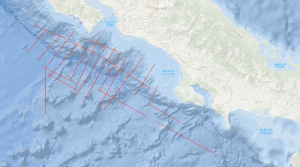
The structure and tectonics of the Pacific margin of Costa Rica were studied by multichannel seismic measurements in parallel with gravity measurements and swathmapping from the Cocos Ridge to Nicoya Peninsula during R/V SONNE cruise SO81 legs 1 and 2 from 18th August to 15th September 1992. In addition geological sampling has been carried out. Dominant structural feature is the buried Costa Rica Terrrane (CRT), a complex and segmented, wedge-shaped unit characterized by relative high seismic velocities of 4 km/s. The thickness of this several tens of kilometres wide zone varies between 0.5 and 3 s (twt). The CRT forms the backstop against which the sediments of the subducting Cocos plate accrete resulting in accumulation of sedimentary mass beneath and in front of the CRT, as well as in simultaneous uplift and fracturing of the CRT. It appears that the distinct CRT is affected locally by raft tectonics, i.e. a form of thin-skinned extension by normal faulting from gravity sliding over a non-stretched oceanic crust. A unit is recognizable between the base of the CRT and the surface of the subducting oceanic crust on most of the seismic lines. This unit is thought to consist mostly of ductile pelagic to hemipelagic shales. Some segment boundaries of the CRT are associated with morphological furrows, 5 to 10 km wide and up to 30 km long running across the slope. We feel that the data acquired during SONNE cruise SO81, and the preliminary results at hand have already improved our knowledge on the geological processes of active continental margins. We are convinced that plausible concepts for the origin of tsunamis and asperities can be developed on the basis of the data collected during SONNE cruises SO81 and SO76. The research of both SONNE cruises are a contribution to the International Decade of Natural Desaster Reduction (IPNDR).
-
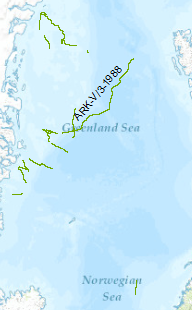
In July/August 1988 a seismic reconnaisance survey was carried out with F.S. Polarstern on the perennially ice covered East Greenland shelf between latitudes 73°N and 81°N. The data format is Society of Exploration Geophysicists SEG Y. 14 reflection seismic lines with a total length of 2.016 km and 12 sonobuoy refraction profiles were recorded. The following results were obtained: •On the wide Holm Land shelf province north of 79°N three possible Cretaceous rift basins were observed. •A buildup of layered extrusive basaltic rocks forming a wedge of seaward dipping reflectors underlies the Holm Land continental slope. •On the Northeastern Greenland shelf province the existence of a wide sedimentary basin was demonstrated north of 76°N. •South of 76°N four volcanic structures from the continent to ocean were observed: The zone of Early Tertiary plateau basalts (zone I) that occur landward of an escarpment, a flat lying basaltic flow unit immediately seaward of the escarpment (zone II), an elongate wedge of seaward dipping reflectors (zone IIIa), a basaltic flow unit which in places shows seaward dipping beds of short length (zone IIIb), and the oceanic crust. •Dyke swarms and intrusions of inferred Neogene age were recognized at several locations.
-
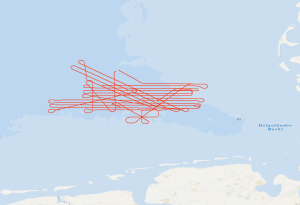
Regarding the use of renewable energy and the reduction of greenhouse-gas emissions, the geological storage of fluids is of particular interest. Therefore, reservoir and barrier formations in the German North Sea come into focus. Due to the widespread distribution of storage and barrier rocks at suitable depths and in combination with a relatively low tectonic overprint, the West Schleswig Block region in the German North Sea shows a high prospectivity for CO2 storage. By means of this high-resolution 2D reflection seismic survey, we want to investigate the potential impairment of geological barriers at the top of geological storage formations (i.e. claystones/mudstones and salt of the Upper Buntsandstein, mudstone dominated formations of the Lower Cretaceous and of the Tertiary). The seismic acquisition setup with a 2400 m active streamer cable with 384 channels will allow a precise image of near-surface structures, such as Quaternary channels, seismic pipe structures, chimneys, polygonal fault systems and crestal faults. In the time period between Nov. 13th and Nov. 24th we acquired 32 lines 2D seismic reflection data (about 1500 km in total) in combination with gravity data, multibeam data and sediment echosounder data. The seismic data resolve the sediments from the seafloor down to the base of the Zechstein. With the acquired data, the sediments of the Mesozoic and Cenozoic up to the seafloor (2-3 seconds of twoway-traveltime) will be imaged in high-resolution for the first time. The imaged fault systems will be investigated regarding their ability to build seal bypass systems. In addition, we acquired seismic data across the Figge Maar blowout crater and we intend to compare these data with the seismic data from the West Schleswig Block.
-
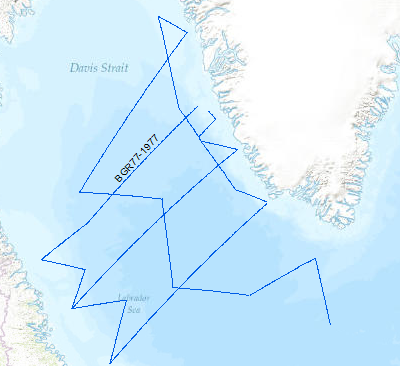
A geophysical reconnaissance survey was carried out in the Labrador Sea and Davis Strait between July and September 1977 by BGR. The data format is Society of Exploration Geophysicists SEG Y. The survey was executed on the research vessel MS Explora. The seismic, magnetic and gravity data from 5931 line-kilometers on 21 lines were recorded on magnetic tape. A 24-fold coverage technique was used with 48 seismic channels (traces), with a 2400m streamer cable, and 23.45 l airgun array. A full integrated computerized satellite navigation system (INDAS III) served as positioning system. Based on a preliminary interpretation of the seismograms, the Labrador Sea was devided into an eastern (Greenland) and western (Canadian) area, seperated by the Mid Labrador Ridge. Within the eastern part of the Labrador Sea the Pre-Cenozoic sediments show three distinct layers, traceable over the entire Greenland area of the sea. In the Cenozoic layer olisthostromes occur. The highest apparent velocity determined from sonobuoy data was 9.26 km/sec. The calculated refractor lies at a depth of approximately 13 km. The seismic section from the sediments on the Canadian side of the Labrador Sea show a uniform series of thick sediments below the Cenozoic cover. The highly disturbed basement is often masked by the multiple reflections from the seafloor. Statements about the nature and structure of the basement can only be made after processing data.
-
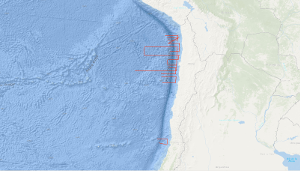
The CINCA marine geoscience investigations on the convergent continental margin of Chile between 19°S and 33°30'S were accomplished during three legs of RV SONNE cruise SO-104, from 22. July to 15. October 1995. The objectives of the first leg are to contribute to an understanding of the geological architecture and of the tectonic mechanism in the area of the Chile convergent zone through a geophysical assessment of the tectonic structures of the Chile continental margin and the adjacent oceanic Nazca plate. During the first leg from 22. July to 24. August 1995 multichannel seismic reflection data with BGR's new digital streamer were collected along a systematic grid with a total traverse length of 4,494 km simultaneously with the acquisition of magnetic, gravimetric, Hydrosweep and Parasound data over a total traverse length of 7,012 km. GFZ's mobile land array of 12 seismic stations recorded the air gun shots fired by RV SONNE within the CINCA area. Three seismic lines were surveyed between 32°30'S and 33°30'S in the area of the CONDOR project. Here, the surface of the downbending oceanic crust is smooth. The 5,000 m to 6,000 m deep trench floor is underlain by sediments, in excess 2,500 m thick. The inner trench slope consists of a landward thickening accretionary wedge which terminates against a body forming the base of a fore arc basin near Valparaiso. The principal area of the CINCA project extends between 19°S and 26°S and comprises the convergent continental margin, the Peru-Chile trench and the seaward adjacent part of the Nazca plate up to approximately 75°W longitude. The tectonic regime of these units of the CINCA area is very different from the tectonic system of the respective units of the CONDOR area. The Eocene-aged and sediment-starved oceanic crust of the Nazca plate becomes blockfaulted when approaching the outer trench slope break. The 50 km to 70 km wide outer trench slope is characterized by a complex system of horst and graben structures in the CINCA area probably resulting from the strong downbending. Steep fault scarps forming the flanks of the horsts reach vertical offsets varying between few hundreds of metres to 1,000 m, and locally even more. The 7,000 m to 8,l00 m deep trench is very narrow and mostly sediment-starved in the CINCA area. Morphology and architecture of the continental margin of the CINCA area are controlled by planar and listric faulting and tilted blocks of inferred continental nature, which apparently slid down into the trench. The inferred continental blocks, overlying a reflective mass, are covered by sediments of presumably turbiditic nature. An accretionary wedge is difficult to define on the seismic single channel records from the CINCA area. However, processed seismic data show a deep reflective mass underlying the downfaulted blocks of inferred continental nature. This deep reflective mass is interpreted to consist of a tectonically eroded and underplated continental crust-basalt melange forming the transition between the downfaulted continental upper plate and the subducting oceanic lower plate. Complex structural highs of still unknown origin and nature have been observed on the upper continental slope at 20°S, 24°S and 25°S. The northernmost structural high represents the seaward termination of the Iquique fore arc basin. The accuracy of the acquired gravity and bathymetric data is very good, i.e. better than 1 mGal and less than 10 m. The Chile trench is associated with strong negative gravity anomalies, and the continental margin is characterized by several positive and negative gravity anomalies of varying size and amount. The first results of magnetic modeling show, that the intensive blockfaulting of the oceanic crust across the outer trench slope causes no loss of the magnetization of the oceanic crust. The air gun shots fired by RV SONNE in 50 m intervals along 17 seismic traverses were recorded by GFZ's mobile land array in the coastal area of Chile. Good quality data were obtained out to about 100 km distance and in some cases even out to about 150 km.
 www.geodatenkatalog.de (S3L)
www.geodatenkatalog.de (S3L)